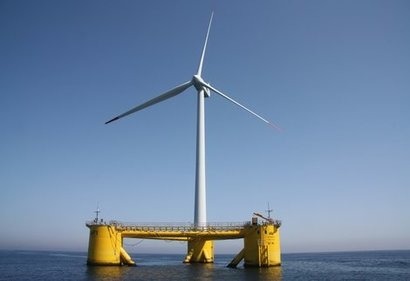
Such a course of action would enable costs to be brought down further. The recommendation came as the ETI released data from its research into offshore wind in the UK including a FEED (front end engineering design) study into its floating platform demonstration project. The ETI suggests that more work should be carried out to develop floating offshore wind platforms alongside producing bigger more durable blades that can be assembled close to site to reduce operational costs. In waters less than 30 metres deep, ETI analysis points to fixed foundations offering the prime solution from a cost-effective perspective but when you go more than 50 metres deep, floating foundations would provide the lowest cost solutions.
Larger turbine blades also make a difference to the cost of energy but how they are constructed matters as much as the physical length in reducing capital costs per MW and enabling greater energy yield. Without manufacturing and material improvements a longer blade will be heavier and this can negate other performance benefits. ETI believes that if manufacturing solutions can be found to allow for modular assembly close to deployment locations this can also make a material difference to the operational cost of offshore wind. This was evidenced in its partnership with Blade Dynamics, a UK SME subsequently purchased by GE, who worked on an ETI project to develop larger blade technology through new design and manufacturing concepts – by producing blades as a series of sub-sections to deliver improvements in quality, cost, transportability and performance.
Current developers of larger windfarms can also be constrained by the wishes and needs of multiple stakeholders which has in the recent past restricted the deployment levels of offshore wind. The ETI believes that by taking another approach and potentially absorbing consenting costs this could become a game-changer for the UK market by making offshore wind more attractive to investors.
In Holland for example consenting costs are absorbed by the Government (in July 2016 DONG Energy won a tender for new Dutch wind farms at 72 euros – approximately £62 per MWh) and the ETI says if the UK was to follow this model then it has a ready-made solution for a consenting managing agent in The Crown Estate.
“Our work has consistently shown that offshore wind can have a significant role in the UK’s energy mix. To date costs have come down significantly (approximately 50 percent over the last 10 years) but we believe they can come down further through the employment of new policy and technology levers” said Andrew Scott, ETI Offshore Renewables Programme Manager. “Offshore Wind is not simply competing with other renewable sources but with other technologies generating low carbon electricity. From our work we see that there is a clear and credible trajectory to delivering subsidy free UK commercial offshore wind farms as part of the UK 2050 energy mix.”
Mr Scott added that when the ETI started work in this area, it modelled the role of offshore wind in a least-cost 2050 UK energy system to meet the country’s climate change targets. At that time it was seen as a hedging option to fill the gap if other technologies did not progress. However, during the last decade offshore wind’s role has changed such that it is now a core component of a least cost balanced 2050 energy system delivering a low carbon transition alongside new nuclear, carbon capture and storage, bioenergy, gas, offshore renewables (predominantly wind) and efficiencies in the heating of buildings and transport fleets, both heavy duty and light vehicles. If industry can find routes to more repeatable manufacture of bigger turbine blades – such as in “kit form” close to site – it could lead to even further cost reductions as well as opening up export market opportunities.
There is also a continued need for the sector to learn by doing. The industry needs to increase its practical experience through even further deployment, development and demonstration of new technologies and learn from this to contain operational costs. The ETI has also identified that the consenting and approval process should be streamlined as this can have a negative impact on developers wanting to build larger offshore wind farms. The advancement of floating technology matters because it opens up more of the sea bed. More emphasis should be placed on floating turbine development as floating turbines should be more economic for high wind, deep water sites – the best locations to exploit UK resources.
During 2017 the ETI will be releasing additional technical data and reports from projects delivered across its technology programmes over the last 10 years. It has just released to its website material from its Offshore Wind programme in the areas of concept turbine designs, feasibility studies of tension leg platforms and wind turbine monitoring to help inform the debate in this area in the UK.
For additional information:

